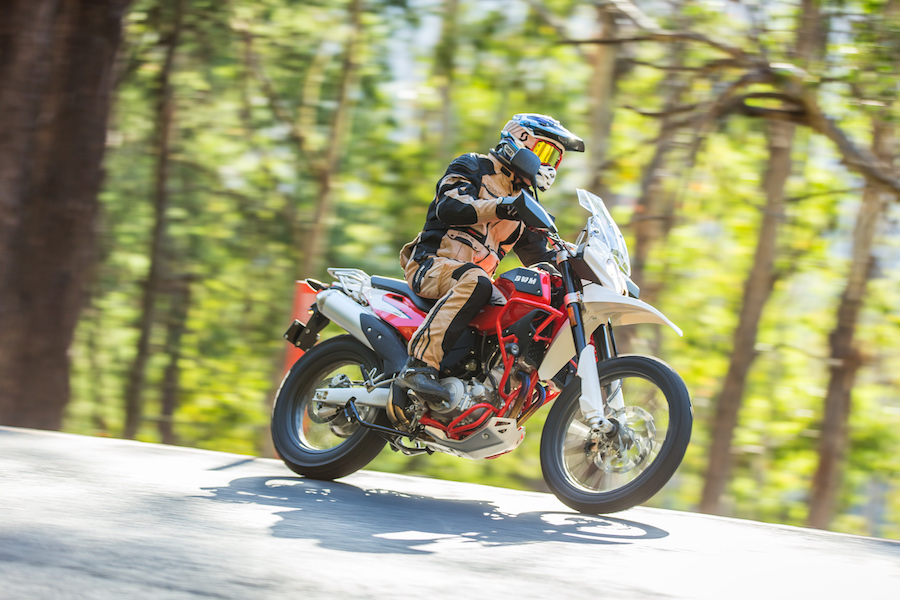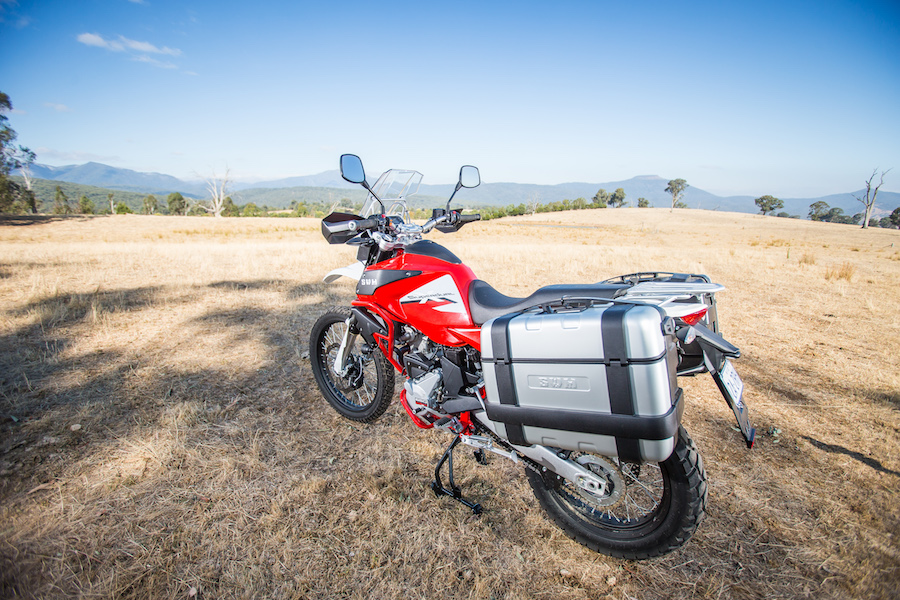Heading bush is part of the Australian dream and this Italian has made it a whole lot easier
Breaking free from reality is harder than it’s ever been. The hustle and bustle of modern- life stifles adventure to a point where, eventually, we simply need an escape. As riders, there are many choices available to achieve this, but one genre growing in both numbers and stature is the adventure segment. More riders than ever before are rolling out of town in search of uninhabited lands, setting up tents and drinking-in the tranquillity.

This newish trend has seen an ever-increasing range of adventure-capable bikes hitting our shores, so it has never been easier to pack up and head off across our great land in a quest for discovery.
It can be a costly discovery, though, with the range-topping bikes equipped with panniers, crash bars and swags of gizmos often costing well over $30,000.
Thankfully, there is also an increasing number of alternatives for the rider who needs their dollar to stretch a little further. The genre’s gaining popularity is giving would-be adventurers a vast array of affordable choices (see sidebar).
Enter SWM’s new Superdual X. At $10,490 plus on-roads complete with panniers and riding lights – as part of an introductory offer – the 600cc go-anywhere bike is well and truly ready for adventure at a fraction of the cost of some of its rivals.
Being an obscure brand, the factory knew that, in order to make this model succeed, the bike needed to be strong and reliable, and it needed to be ready from the get-go.
It’s designed for the rider who wants to venture a little bit deeper into the bush, but without having to dig a little deeper into their pockets.
If you own or have owned an adventure bike, you already know first-hand that it’s only a matter of time before it gets dropped, battered or falls off the stand at the most inopportune time. For these reasons, they need to be built tough. Some are genuinely solid, but some feel like they’d break on a pebble-covered road.
Build quality is something that should genuinely be considered if you’re in the market for an adventure bike – out in the boondocks, reliability is a must.
And the Superdual X is one tough little machine; partly due to its rock-solid bones that stem back to its Husqvarna heritage (see sidebar), and partly due to the extras the Italian firm has added to the package. It’s a far more capable and robust machine than the 2011 Husqvarna TE 630 on which it is based.
Aesthetically it’s a completely different bike to look at and shares nothing externally from the original machine. It is more similar in its lines to its road-oriented Superdual T sibling with its 17- and 19-wheel size combination.

The bike has a pair of pipes exiting from under the seat, which keep it looking balanced from the rear. From the front, when the panniers aren’t fitted, it’s narrow and sleek and has a trailbike size and look about it.
But this bike is not built around its looks alone. It’s fitted with a swathe of high-quality componentry that helps it achieve its design brief of getting you to Bourke and back, hopefully without needing to open the tool pack.
The first and most obvious thing that any adventure bike needs is a long fuel range and, with a claimed range of 400-450km from the Superdual’s significant 18-litre tank, that box is ticked. It doesn’t look overly large and hides its fuel load well, staying tucked in behind the crash bars.
The steel tank is protected by screw-on crash panels for when the inevitable happens, turning an otherwise terminal problem into a merely cosmetic one fixed by a relatively cheap replacement.
Further protection is provided by a set of heavy-duty crash bars that run down from the underside of the tank, helping to look after the engine ancillaries. They work too – as we found out when one journo at the launch got it all wrong. In what was a decent get-off, the radiator, oil filter and all side covers remained in one piece, which meant we were quickly underway again rather than trying to figure out what to do next.
A proper 3.5mm-thick alloy bash plate comes standard and wraps right around the underneath of the X, offering aftermarket-type protection. It marries up with the lower engine protection bar, once again lessening the chance of damage miles from nowhere.
The rear pannier racks work well at protecting the exhaust and they are strong enough to withstand impacts on rides when the actual panniers are left at home.
Rider protection hasn’t been forgotten – an important subject on an adventure machine.
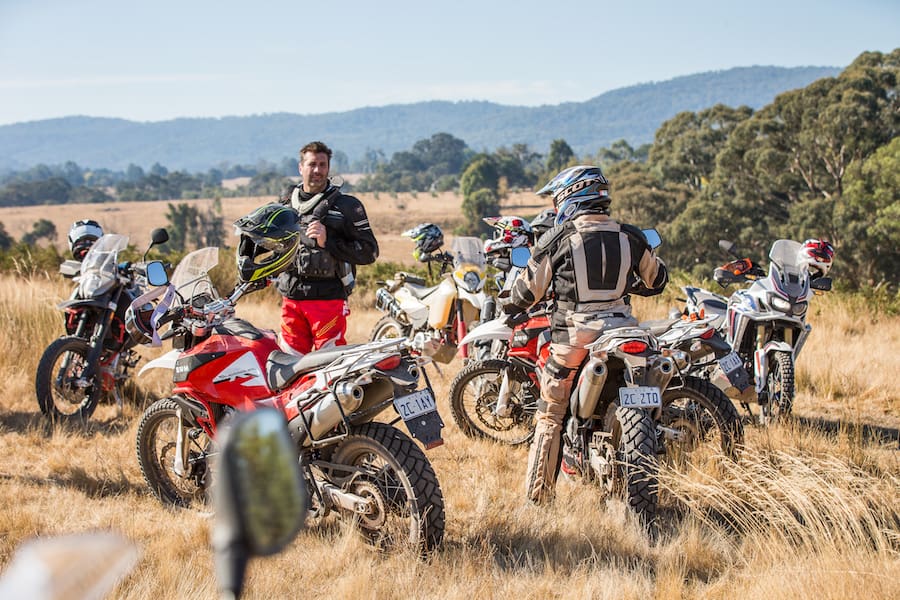
Wraparound black plastic handguards protect your hands from stones and weather, and the screen works well in directing the wind away from your head and body, despite its small size.
The seat has two options, with the (standard) lower sculptured seat as well as an optional, higher version. My short-legged 173cm body was happy in the standard saddle, though there wasn’t a lot of room to move around. There’s more legroom to be had with the higher option, but then that raises the seat height, which I wouldn’t want to do if I was buying the bike.
As part of the introductory offer, SWM is offering a GT kit for no extra charge. It consists of a pair of 32-litre panniers and a set of LED riding lights. The hard-case panniers are made by Givi and are of typically excellent quality; having been in the game for an eternity, you can be confident that the luggage that starts the trip will still be there at the end.
Another well thought out addition that complements the long-distance theme is a standard carry rack that is fitted above the rear guard. It’s a decent size and is also strong enough to lever off if you need to get the bike out of trouble, with a couple of grab bars on each side. It’s a handy place to grab if you need to put the bike on the centrestand too.
Yes, a centre stand. It mightn’t sound so important now while you’re sitting on the couch reading this terrific magazine, but if you’ve ever had a puncture in the wild, you’ll appreciate just how important a stand is. Pop the bike on the stand, wheel out, job done.
Vibrations are a killer to any adventure nut and can often mean the difference between an enjoyable holiday or a nightmare in the saddle. SWM has done a lot to ensure vibrations are reduced; as well as the counterbalanced twin-cam Husky engine, it has added a rubber cush drive in the rear hub – which absorbs backlash and reduces wear on your gearbox – and added rubber inserts in the serrated enduro pegs.
The dash is a small, almost enduro-like LCD item, but it’s very functional. It has a digital speedo and tacho and, importantly on a bike like this, a fuel gauge. It tucks in behind the headlight cowl and just in front of the aluminium handlebar, and the switchblocks are straightforward items.
The off-road roots of this bike allow it to accommodate different sized riders. While in the roadbike world riders just get on a bike and ride it, that’s not the case in the off-road scene.

The standard bar position is a little close to the rider as it comes from the factory, but there’s ample adjustability. You can tilt the bars forward by loosening the four bar-clamp bolts or, if that’s still not enough, it’s possible to reverse the bottom bar-clamp mounts and gain a bit more room.
A lot of the guys on the test ride tried this and it seemed to be enough for them, but I was happy with the positioning of my bars where they were. And the pegs can be lowered by about 20mm, by altering the assembly order of the peg springs.
The rest of the bike is all class.
The powerplant is based on the 600cc TE Husky bottom-end with an Athena barrel and piston fitted. The double overhead cam water-cooled engine is Euro4 compliant, using an Italian GET ignition that has the possibility for two maps (one standard) and for tuning by a dealer with the tuning tool. That does open the possibilities of tuning your bike properly, especially when modding pipes.
The throttle body is a proven Mikuni D45 EFI unit, as used on the SWM 650 and 500 R models, and it works well.
The engine provides a steady push of power up to its peak of 43kW (58hp) and it revs cleanly all the way to 11,000rpm.
A LAMS version is available and pumps out 35kW. While neither are going to win the Finke, it’s more than enough to go damn fast on either the dirt or the tarmac.

The frame is pure Husky and, although the geometry is a few years old now, it’s still very good, offering precision and feel. Its steel tubes run from a single backbone and make a double-cradle configuration that has an alloy bolt-on subframe.
It’s quite a stable bike to ride in the dirt, and one thing that the base-model Husqvarna did do well was handle.
But the Superdual X is also designed to be a capable and durable tourer, and the frame plays a big part in achieving that.
The swingarm is also strong, and has high-quality adjusters bolting the rear wheel in, which will make fixing a flat quick and easy.
Suspension is new and consists of a 45mm Fastace fork up front and a Sachs monoshock on the rear. The fork offers rebound damping adjustment and 210mm of travel, giving the bike a decent amount of off-road prowess while not being as aggressive as a proper hard-edged dirtbike. The rear Sachs unit has 270mm of travel and offers adjustability for preload, compression and rebound damping.
The 21- and 18-inch rims are shod with Metzeler Sahara rubber.
Brakes are by Brembo and, considering the vast spectrum they need to work in, they do a good all-round job. The single 300mm disc up front is certainly powerful enough for the dirt, but doesn’t have the stopping power of a twin-disc set-up on the bitumen. Overall though, a great compromise.
The ABS is switchable at the rear only. I had some issue with this on the dirt when occasionally the front brake thought I had no grip so released on the slippery surface, creating some interesting moments. I’m sure there will be a fix (if there isn’t one already) to be able to switch both front and rear ABS off so it stops as a dirtbike should.
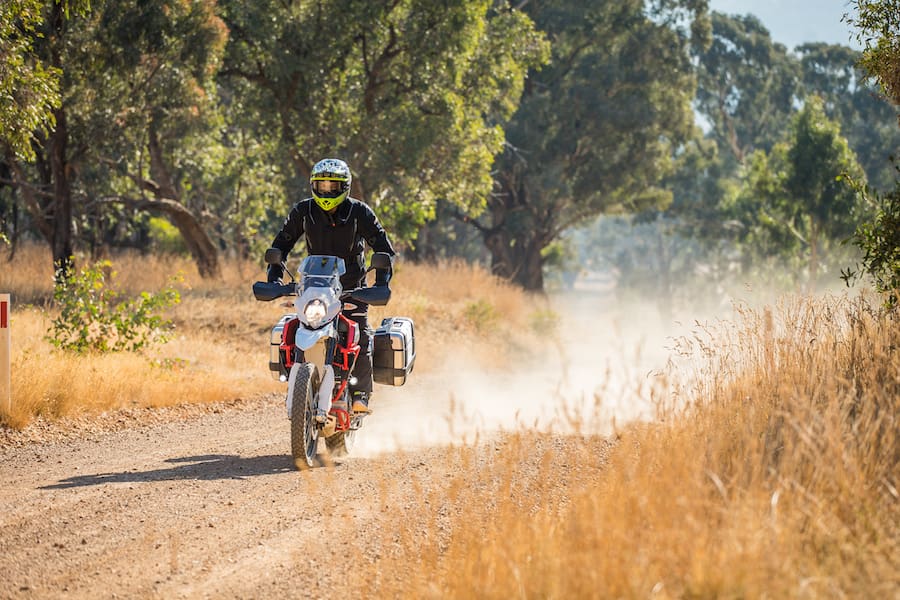
We rode the bike through the Victorian high country on all manner of surfaces. The grip on the road was good and we had a lot of fun carving our way through the tight curves up to Mt Buller. While perhaps not as competent as a roadbike or a big-bore adventurer, it was capable on the tarmac – and far better than a trailbike. The screen offered good protection, the engine was smooth and vibration free.
When we hit Buller, things got dirty and the X handled the situation extremely well. It felt a little top heavy with a full 18 litres of fuel, but that’s a small price to pay for its range. Once I got back into the swing of the bike moving around underneath me, it felt a lot like a trailbike. On the fire trails, it doesn’t have that big-bike feel and gives you the confidence to carve through the turns that bit faster. On the open fire trails, there would be no advantage over a bigger adventure bike, but when the going gets tight that’s when the SWM shines.
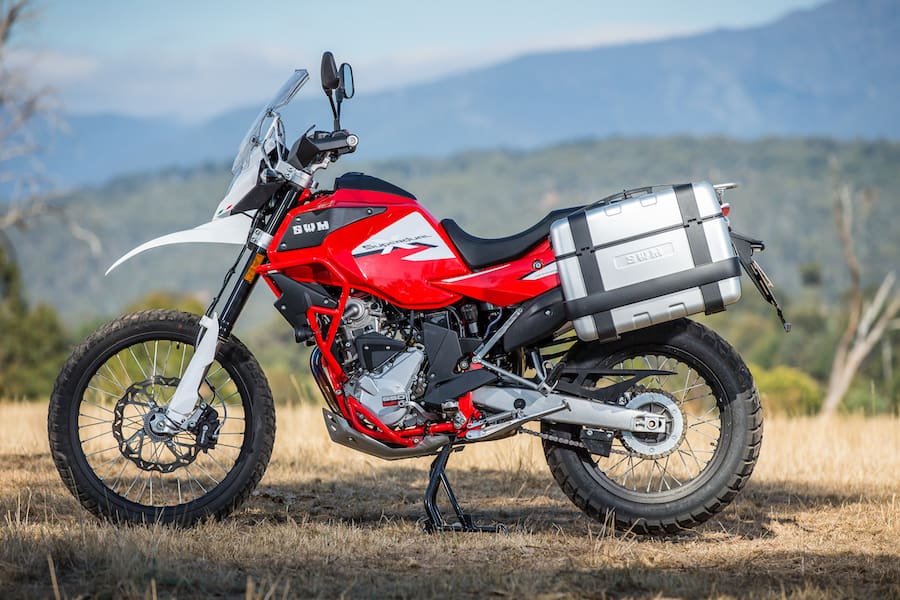
We ended up hitting a log-strewn single track, one where no big-bore bike dare tread. The X felt light and the Metzelers provided good grip in the tough going, proving to be great all-round tyres. The other advantage in the tight stuff was the weight; manageable, and easy to pick up if needed. It has ample steering lock, which helped on the tight track, and its narrowness allows you to work through most obstacles.
The Superdual X does not excel in any one area, but it’s one of only a handful of bikes that can do everything well. It could be ridden across the Nullarbor or the fire trails of the highlands.
When the opportunity arises, click the indicator and head deep into the bush with confidence. SWM did well to have the Husqvarna TE 630 as the platform for this bike, but it is all the well thought out extras that make this 2018 bike worth so much more than the Husky ever was.
As appeared in AMCN (Vol 67 No 21)

SW-WHO?
SWM was founded in 1971 by Piero Sironi and Fausto Vergani in Vimercate, near Milan. They called it SVVM (Sironi Vergani Vimercate Milano), which soon got shortened to SWM (squint and you’ll see why).
It started selling trials bikes fitted with Sachs and then Rotax engines before moving into the enduro scene. Its racing successes started in 1981 when Giles Burgat won the World Trials Championship. But the company struck financial hardship and it went into receivership in 1984.
SWM was revived in 2014 after Husqvarna was sold to KTM. The modern former Husqvarna factory gained funding from China’s Shineray group and, driven by former Cagiva, Aprilia and Husqvarna engineer Ampelio Machii, the brand is forging ahead. With many new models and concepts coming, SWM will surely regain the strength it once had.
TEST Steve Martin PHOTOGRAPHY Ikapture

